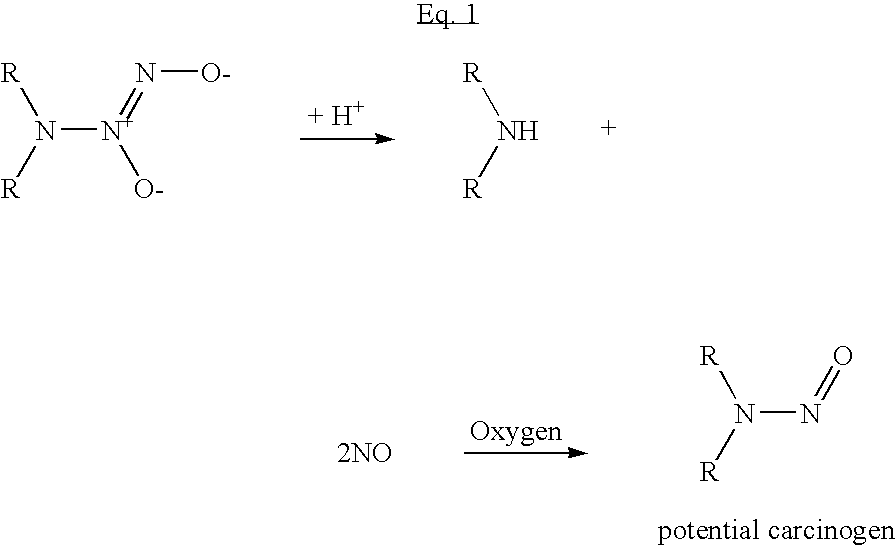Nitric oxide-releasing molecules
a technology of nitric oxide and releasing molecules, which is applied in the field of nitric oxide release molecules, can solve the problems of nitrosamine formation, difficult development of compounds, and potential formation of carcinogens (nitrosamines) upon decomposition and release,
- Summary
- Abstract
- Description
- Claims
- Application Information
AI Technical Summary
Benefits of technology
Problems solved by technology
Method used
Image
Examples
example 1
[0064]This example converts a benzyl ether into an NO-releasing agent.
[0065]Commercially available from Sigma-Aldrich is benzyl methyl ether, PhCH2OCH3. To 100 ml of diethyl ether in a Parr pressure vessel, 3.62 g (0.032 moles) of potassium t-butoxide is added with stirring. To this suspension 2 ml (0.016 moles) of benzyl methyl ether is slowly added. Oxygen is removed from the flask by alternating cycles (10) of inert gas pressurization and venting. The stirred solution is then exposed to 80 psi NO gas at room temperature for 24 hours. When the reaction is complete, i.e. no more NO gas was consumed, then the head space is purged of NO gas and the tan solid filtered and washed with ether. The UV-vis spectrum of this material has a peak at 258 nm and it yields a positive Greiss reaction. The crude tan product is analyzed for NO release. A solution is made of 6.7 mg of the tan product in 0.1 ml of 10 mM NaOH. In a reactor vessel containing 3 ml of pH 7.4 buffer is injected the 0.1 ml ...
example 2
[0066]This example describes methods to convert a benzyl-NR molecule into a carbon-based diazeniumdiolate.
[0067]In a Parr pressure vessel, 2.0 g (0.010 moles) of commercially available trimethylammoniumbenzyl chloride is added to 200 ml of t-butanol. With stirring, 3.62 g (0.032 moles) of potassium t-butoxide is slowly added. The head space is flushed with an inert gas before exposure to 60 psi NO gas. The reaction is allowed to proceed at room temperature for 24 hours or until no further consumption of NO gas is observed. The resulting diazeniumdiolate salt is filtered, washed with t-butanol and diethyl ether, and vacuum dried before analysis.
example 3
[0068]This example describes methods to convert a benzyl-SR molecule into a carbon based diazeniumdiolate.
[0069]Commercially available benzyl chloride and sodium ethanethiolate are subjected to a nucleophilic substitution reaction to produce PhCH2SC2H5 after isolation and purification. In a Parr pressure vessel, 2.0 g (0.013 moles) of PhCH2SC2H5 is added to 200 ml of t-butanol. With stirring, 2.94 g (0.026 moles) of potassium t-butoxide is slowly added. The head space is flushed with an inert gas before exposure to 60 psi NO gas. The reaction is allowed to proceed at room temperature for 24 hours or until no further consumption of NO gas is observed. The resulting diazeniumdiolate salt is filtered, washed with t-butanol and diethyl ether, and vacuum dried before analysis.
PUM
| Property | Measurement | Unit |
|---|---|---|
| pH | aaaaa | aaaaa |
| weight | aaaaa | aaaaa |
| weight | aaaaa | aaaaa |
Abstract
Description
Claims
Application Information
 Login to View More
Login to View More - R&D
- Intellectual Property
- Life Sciences
- Materials
- Tech Scout
- Unparalleled Data Quality
- Higher Quality Content
- 60% Fewer Hallucinations
Browse by: Latest US Patents, China's latest patents, Technical Efficacy Thesaurus, Application Domain, Technology Topic, Popular Technical Reports.
© 2025 PatSnap. All rights reserved.Legal|Privacy policy|Modern Slavery Act Transparency Statement|Sitemap|About US| Contact US: help@patsnap.com



